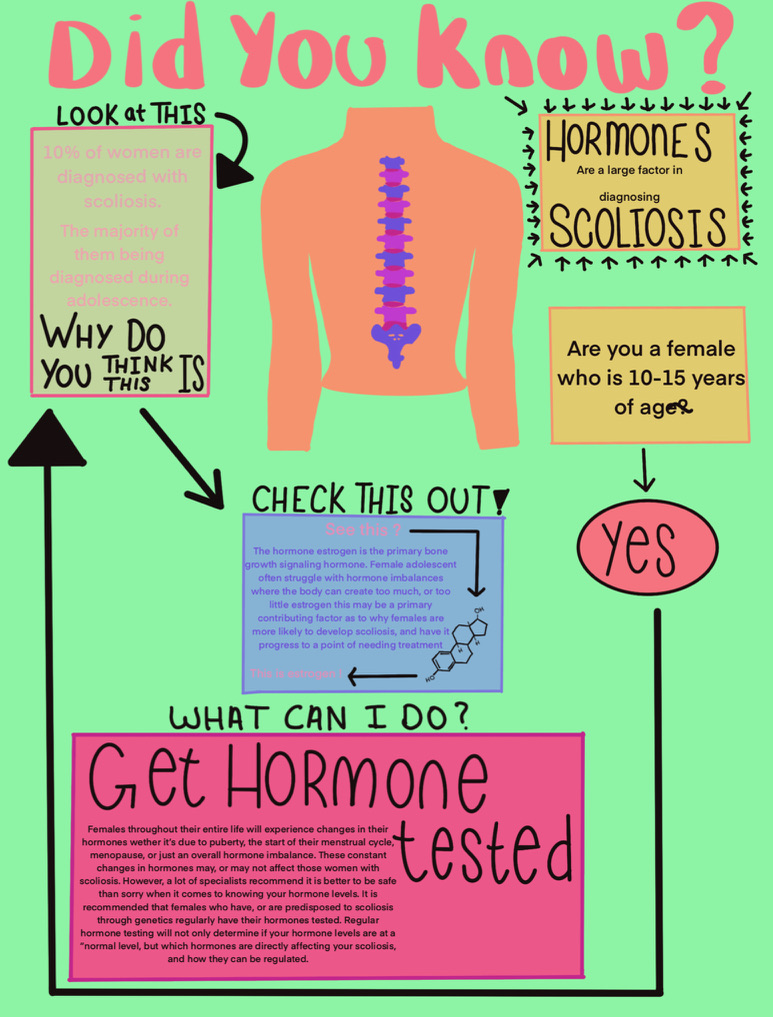
Tia Campanelli November 20, 2022 STEAM Project
For my STEAM Project I have chosen to answer the Unit 4 objective “how is bone development hormonally regulated” by researching scoliosis. After learning about the skeletal system in Unit 4, we learned a lot about bone development, and how hormones play a crucial part. Scoliosis is a disease that affects millions including myself, and other close relatives I have which is why I have chosen to research beyond lectures, and notes about this topic.
Scoliosis is the abnormal twisting and curvature of the spine that currently has no known cause, or cure. This spinal disease affects nearly 2 to 3 percent of the United States population. According to the National Scoliosis Foundation, nearly 4 million people across the United States have currently been diagnosed. Often when we think of scoliosis we think of those who develop it at a more elderly age. However, did you know that the majority of the 4 million people diagnosed are actually adolescents? The most common type of scoliosis, which is also known as idiopathic scoliosis is typically diagnosed around the ages of 10 to 15 years old. While this type of scoliosis is typically minor, and rarely needs aggressive treatment, some patients do require surgery in order to help correct spinal curvature. Out of those who do develop this disease females are 10 times more likely to develop spinal curvature over men.
Why are females more likely to develop scoliosis than men? As previously stated doctors and researchers do not know an exact cause for scoliosis. However, as we learned in Unit 4, hormones make a large contribution to bone growth and development. This is also applied to the development of scoliosis. More specifically the hormone estrogen is a primary bone growth
signaling hormone. While men do also contain estrogen in their bodies females produce a significantly larger amount of estrogen. Female adolescents often struggle with hormone imbalances where the body can create too much, or too little estrogen. This may be a primary example as to why Adolescent females are more likely to develop scoliosis, and have it progress to a point of needing treatment.
Is there anything I can do with my hormones to help with the progression of scoliosis? Females throughout their entire life will experience changes in their hormones whether it is due to puberty, the start of their menstrual cycles, menopause, or just an overall hormone imbalance. This change in hormone levels may, or may not affect females with this spinal disease. However, a lot of specialists recommend being safe rather than sorry when it comes to knowing your hormone levels. It is recommended that females who have, or are predisposed to the condition genetically regularly have their hormones tested. Hormone testing will not only measure if your hormones are at a ‘normal’ level, but also which hormones are directly affecting your scoliosis, and how they can be regulated.
With as many young girls who are affected by this condition I believe it is crucial we spread more information on what can be done to prevent progression of scoliosis. Hormone management is such a crucial part of adolescent girls’ health not only for the reason of scoliosis, but bone density and development as a whole. The information that has been provided in my essay, and poster is only some of the information I would have known when being diagnosed with scoliosis at age 13.
Bibliography
Center, P. by S. C. (2018, February 16). Scoliosis facts and figures – spine correction center. Spine Correction Center of the Rockies. Retrieved November 22, 2022, from https://www.spinecorrectioncenter.com/scoliosis-facts-and-figures/#:~:text=Did%20you%2 0know%20that%20about,and%20symptoms%20of%20the%20condition.
Scoliosis symptoms and treatments. symptoms & treatments – Illnesses & conditions | NHS inform. (n.d.). Retrieved November 22, 2022, from https://www.nhsinform.scot/illnesses-and-conditions/muscle-bone-and-joints/conditions/sc oliosis
ScoliSMART. (2022, March 29). How hormone testing can help you treat your scoliosis condition while aging? ScoliSMART Blog. Retrieved November 22, 2022, from https://www.treatingscoliosis.com/blog/aging-with-scoliosis/#:~:text=As%20mentioned%2 0above%2C%20an%20important,directly%20linked%20to%20estrogen%20levels.
Support. (2020, August 21). Our team: Spine health: Neck or back pain: Scoliosis: Books. National Spine Health Foundation. Retrieved November 22, 2022, from https://spinehealth.org/scoliosis-books-5-reads-for-young-people/?gclid=Cj0KCQiAg_KbB hDLARIsANx7wAyrJ52zQEzOrqR6j5ZuEEWSdYDHqpsTNVX4dU-BSMTwRbHklTCT 17EaAvFsEALw_wcB

Tia Campanelli’s project was titled “How hormones contribute to scoliosis in adolescent girls- STEAM Project 2022.” This project delved into the course objective of explaining how bone development is hormonally regulated, a subject explored in class during Unit 4. The visual element is an engaging flowchart that catches the eye, and delivers a lot of information with relatively few words.
Scoliosis is an abnormal twisting or curving of the spine that affects 2-3 percent of the population in the United States. They identify that estrogen is the primary bone growth signaling hormone in adolescent girls, and that an imbalance of this hormone can lead to a condition such as scoliosis. Men get scoliosis much less often than females because they produce estrogen at a drastically lower level.